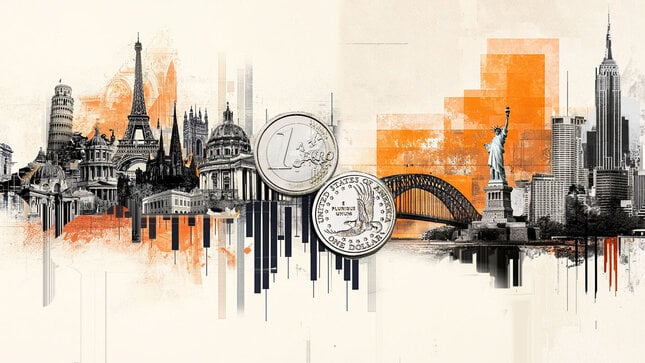- USD/CHF recovers further above 0.8850 as the US Dollar bounces back strongly.
- Traders doubt whether the Fed will cut interest rates in December.
- USD/CHF finds a cushion near the 50% Fibo retracement around 0.8800.
The USD/CHF pair extends its recovery above 0.8850 in the North American trading session on Wednesday. The Swiss Franc pair rises as the US Dollar (USD) bounces back strongly amid doubts about whether the Federal Reserve (Fed) will continue its policy-easing cycle in the December meeting.
According to the CME FedWatch tool, trades see a 59% chance that there will be 25 basis points (bps) interest rate cut next month, which will push interest rates lower to 4.25%-4.50%. The probability of a Fed rate cut has diminished from 82.5% a week ago as investors expect President-elect Donald Trump’s economic agenda will boost inflation in the United States (US) along with its economic growth.
Meanwhile, global brokerage firm Nomura expects the Fed to pause the policy-easing cycle in December. "We currently expect tariffs will drive realized inflation higher by the summer, and risks are skewed towards an earlier and more prolonged pause,” analysts at Nomura said.
The Swiss Franc (CHF) witnessed buying interest on Tuesday as a fresh escalation in the Russia-Ukraine war improved its safe-haven bid. However, it turned out short-lived as Russian Foreign Minister Sergei Lavrov pushed back expectations of a nuclear attack.
USD/CHF bounces back after a mild correction to a 50% Fibonacci retracement around 0.8800. The Fibo tool is plotted from a May high of 0.9225 to a September low of 0.8375. Upward-sloping 20-day Exponential Moving Average (EMA) near 0.8765 suggests that the near-term trend is bullish.
The 14-day Relative Strength Index (RSI) oscillates in the 60.00-80.00 range, suggesting a strong bullish momentum.
The asset could rise to near the July 5 low of 0.8950 and the psychological resistance of 0.9000 after breaking above the November 14 high of 0.8918.
In an alternate scenario, a downside move below 38.2% Fibo retracement at 0.8700 could drag the asset towards the October 23 low of 0.8650, followed by the November low of 0.8616.
USD/CHF daily chart
Swiss Franc FAQs
The Swiss Franc (CHF) is Switzerland’s official currency. It is among the top ten most traded currencies globally, reaching volumes that well exceed the size of the Swiss economy. Its value is determined by the broad market sentiment, the country’s economic health or action taken by the Swiss National Bank (SNB), among other factors. Between 2011 and 2015, the Swiss Franc was pegged to the Euro (EUR). The peg was abruptly removed, resulting in a more than 20% increase in the Franc’s value, causing a turmoil in markets. Even though the peg isn’t in force anymore, CHF fortunes tend to be highly correlated with the Euro ones due to the high dependency of the Swiss economy on the neighboring Eurozone.
The Swiss Franc (CHF) is considered a safe-haven asset, or a currency that investors tend to buy in times of market stress. This is due to the perceived status of Switzerland in the world: a stable economy, a strong export sector, big central bank reserves or a longstanding political stance towards neutrality in global conflicts make the country’s currency a good choice for investors fleeing from risks. Turbulent times are likely to strengthen CHF value against other currencies that are seen as more risky to invest in.
The Swiss National Bank (SNB) meets four times a year – once every quarter, less than other major central banks – to decide on monetary policy. The bank aims for an annual inflation rate of less than 2%. When inflation is above target or forecasted to be above target in the foreseeable future, the bank will attempt to tame price growth by raising its policy rate. Higher interest rates are generally positive for the Swiss Franc (CHF) as they lead to higher yields, making the country a more attractive place for investors. On the contrary, lower interest rates tend to weaken CHF.
Macroeconomic data releases in Switzerland are key to assessing the state of the economy and can impact the Swiss Franc’s (CHF) valuation. The Swiss economy is broadly stable, but any sudden change in economic growth, inflation, current account or the central bank’s currency reserves have the potential to trigger moves in CHF. Generally, high economic growth, low unemployment and high confidence are good for CHF. Conversely, if economic data points to weakening momentum, CHF is likely to depreciate.
As a small and open economy, Switzerland is heavily dependent on the health of the neighboring Eurozone economies. The broader European Union is Switzerland’s main economic partner and a key political ally, so macroeconomic and monetary policy stability in the Eurozone is essential for Switzerland and, thus, for the Swiss Franc (CHF). With such dependency, some models suggest that the correlation between the fortunes of the Euro (EUR) and the CHF is more than 90%, or close to perfect.
Information on these pages contains forward-looking statements that involve risks and uncertainties. Markets and instruments profiled on this page are for informational purposes only and should not in any way come across as a recommendation to buy or sell in these assets. You should do your own thorough research before making any investment decisions. FXStreet does not in any way guarantee that this information is free from mistakes, errors, or material misstatements. It also does not guarantee that this information is of a timely nature. Investing in Open Markets involves a great deal of risk, including the loss of all or a portion of your investment, as well as emotional distress. All risks, losses and costs associated with investing, including total loss of principal, are your responsibility. The views and opinions expressed in this article are those of the authors and do not necessarily reflect the official policy or position of FXStreet nor its advertisers. The author will not be held responsible for information that is found at the end of links posted on this page.
If not otherwise explicitly mentioned in the body of the article, at the time of writing, the author has no position in any stock mentioned in this article and no business relationship with any company mentioned. The author has not received compensation for writing this article, other than from FXStreet.
FXStreet and the author do not provide personalized recommendations. The author makes no representations as to the accuracy, completeness, or suitability of this information. FXStreet and the author will not be liable for any errors, omissions or any losses, injuries or damages arising from this information and its display or use. Errors and omissions excepted.
The author and FXStreet are not registered investment advisors and nothing in this article is intended to be investment advice.
Recommended content
Editors’ Picks

AUD/USD faces the next key hurdle at 0.6400
AUD/USD added to Tuesday’s optimism and surpassed the key 0.6300 mark on the back of extra weakness in the US Dollar prior to President Trump’s announcements of reciprocal tariffs.

EUR/USD looks to retest 1.0900
EUR/USD surged to multi-day highs in response to further selling pressure on the Greenback and news that the EU could be planning measures to alleviate Trump’s tariffs.

Gold looks consolidative near $3,120 ahead of Trump's “Liberation Day”
Gold is regaining momentum, climbing above $3,120 after a slight pullback from Tuesday’s near-record high of $3,150. Retreating US yields are bolstering XAU/USD, ahead of President Trump's official announcement of the reciprocal tariff measures later this Wednesday.

Grayscale launches Bitcoin options ETF with a focus on income generation
In a press release on Wednesday, Grayscale announced the launch of Bitcoin options-based ETFs, the Grayscale Bitcoin Covered Call ETF (BTCC) and Grayscale Bitcoin Premium Income ETF (BPI).

Is the US economy headed for a recession?
Leading economists say a recession is more likely than originally expected. With new tariffs set to be launched on April 2, investors and economists are growing more concerned about an economic slowdown or recession.

The Best brokers to trade EUR/USD
SPONSORED Discover the top brokers for trading EUR/USD in 2025. Our list features brokers with competitive spreads, fast execution, and powerful platforms. Whether you're a beginner or an expert, find the right partner to navigate the dynamic Forex market.


